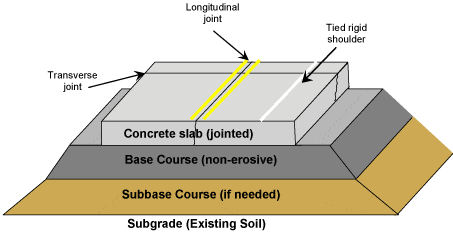There are two types of pavements based on design considerations i.e. flexible pavement and rigid pavement. Difference between flexible and rigid pavements is based on the manner in which the loads are distributed to the subgrade.
Before we differentiate between flexible pavements and rigid pavements, it is better to first know about them. Details of these two are presented below:
Flexible Pavements:
Flexible pavement can be defined as the one consisting of a mixture of asphaltic or bituminous material and aggregates placed on a bed of compacted granular material of appropriate quality in layers over the subgrade. Water bound macadam roads and stabilized soil roads with or without asphaltic toppings are examples of flexible pavements.
The design of flexible pavement is based on the principle that for a load of any magnitude, the intensity of a load diminishes as the load is transmitted downwards from the surface by virtue of spreading over an increasingly larger area, by carrying it deep enough into the ground through successive layers of granular material.

Rigid Pavements:
A rigid pavement is constructed from cement concrete or reinforced concrete slabs. Grouted concrete roads are in the category of semi-rigid pavements.
The design of rigid pavement is based on providing a structural cement concrete slab of sufficient strength to resists the loads from traffic. The rigid pavement has rigidity and high modulus of elasticity to distribute the load over a relatively wide area of soil.

Fig: Rigid Pavement Cross-Section
Minor variations in subgrade strength have little influence on the structural capacity of a rigid pavement. In the design of a rigid pavement, the flexural strength of concrete is the major factor and not the strength of subgrade. Due to this property of pavement, when the subgrade deflects beneath the rigid pavement, the concrete slab is able to bridge over the localized failures and areas of inadequate support from subgrade because of slab action.


 0
0

